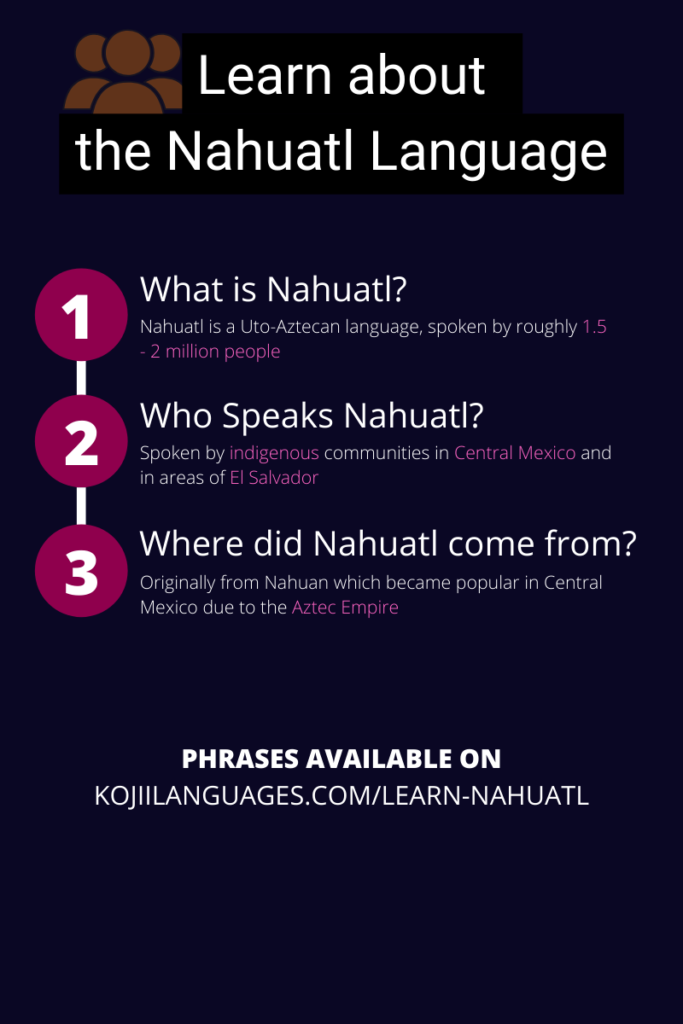What is Nahuatl?
Nahuatl is a Uto-Aztecan language that is currently spoken by, between, 1.5-2 million people around the world. Most of these speakers are located in the Central Mexico region, with some speakers residing in El Salvador.
How do you pronounce Nahuatl?
Nahuatl can be pronounced NAwa, NAwat, or NAwal depending on the region of the speaker. However a common trend in Nahuatl is to place emphasis on the second to last syllable of any given word.
In this case, the -tl at the end is silent.
Nahuatl alphabet and pronunciation
Now it’s time to learn Nahuatl’s alphabet and sound structure. Nahuatl has adopted the latin alphabet, making the reading portion much easier than it used to be when it was written in a semi-writing system.
There are 5 basic vowels in Nahuatl which include: a, e, i, o, and u
| Nahuatl | Example pronunciation |
| a | as in “fAther” |
| e | as in “bEd” |
| i | as in “pEE’ |
| o | as in “ghOst” |
| u | as in “tUne” |
Sometimes you will see “aa”, “ee” or any of these vowels used twice, this simply means to the sound longer. You may also see “a:” or “u:” this is the same as using the letter twice.
Let’s now take a look at the Nahuatl consonants
| Nahuatl | Example pronunciation |
| c | When in front of a, o, or u, it is like the c in “cat” and when in front of e, or i the c is soft like in the word “cease” |
| ch | as in “champion” |
| h | as in “hi” |
| hu | as in “wait”, it takes a “w” like sound |
| l | as in “lamp” |
| m | as in “mom” |
| n | as in “no” |
| p | as in “people” |
| qu | as in “key”, it takes a k sound similar to the c. |
| t | t as in “tall” |
| tl | This is quite tricky, but think of it as the “tl” in atlantic but sharper. |
| tz | as in “pets” |
| x | has a “sh” sound like “sheep” |
| y | as in “yes” |
| z | as in “soft” similar to a soft c |
Who speaks the Nahuatl Language?
Nahuatl is still spoken in rural communities in areas around Central Mexico such as Veracruz, Hidalgo, Puebla, Tlaxcala, and Guerrero. There is also a small community of speakers in El Salvador.
People that speak the Nahuatl language are generally descendants of the Aztec people. While many have moved across Latin America, and to the United States, their origins can be traced to Central Mexico where the Aztec Empire once stood.
History of the Nahuatl Language
In order to effectively learn a language I think it’s important to go over some of its history. So in this case, to learn Nahuatl let’s go over some basic history.
It is believed that Nahuatl, or Classical Nahuan, originated in the deserts in the north of what is now Mexico, and the southwest of the United States. The exact date is unclear, but is was likely before 500 AD.
Sometime around 500 AD the Nahuan people migrated to the valley of Mexico. During this time they adopted agriculture, and urban development as a way of life. After building larger communities, sometime around 700 AD, the Nahuan people rose to power in Central Mexico.
Classical Nahuan to Nahuatl
The second migration in 1200 AD consisted of the Mexica people who settled on the island of Lake Texcoco. This would eventually lead to the construction of Tenochtitlan.
After making an alliance with the Tlxacala, and Tlacopan, the three would form the Aztec Empire. During this time Classical Nahuatl became the dominant language across Central Mexico.
Once the Spanish started to colonize the New World in the 16th century, the language started to integrate with Spanish and form modern day Nahuatl. One major difference being that Nahuatl is now written in the latin alphabet.
Nahuatl vs Mayan
Many people assume that because the Aztec Empire was next to the Mayan people, that their language and culture are similar. However, this is like saying Levantine Arabic (Palestine) is similar to Hebrew because they are next to each other. While there are similarities between Yucatan-based languages and Nahuatl, there are many differences. Grammatically, and phonetically they are unalike. However, yes, because they were next door and both did have contact with each other, there are few similarities in more trivial vocabulary.
A major difference is that the Mayan writing system is considered complete, meaning a writing system that we can decipher. In the 50’s, a linguist by the name Yury Knorozov showed that the Maya glyphs, as they are commonly referred as, could be deciphered and that it was in fact phonetic.
Meanwhile, the Nahuatl, or Classical Nahuan, “writing system” is more hieroglyphics based and not considered a complete writing system.
How can I Learn the Nahuatl Language?
So how can you learn Nahuatl? Well, that all depends on what your goals are. Are you looking to speak the language, read poetry, or simply know a few phrases?
Unlike more common languages like Spanish, French, or Japanese, Nahuatl language learning resources are very limited. Similar to Akateko, most resources are in Spanish.
There are some resources you can use such as the following links:
- https://www.amazon.com/Learn-Nahuatl-Language-Aztecs-Modern/dp/1532960549
- https://www.youtube.com/watch?v=DnQyheXzF0M&t=14s
- https://www.youtube.com/watch?v=eXzM2-qRPes
Basic Nahuatl Phrases to Know
Pialli – Hello
Notoocaa – my name is…
Quenin tica /timohuica? – How are you?
Cualli – Good
Cualli cualli – Very good
Quema – Yes
Amo – No/not (negative)
Ma cualli tonalli – have a good day
What is KOJII and why Nahuatl?
In order to promote awareness for minority languages, KOJII, has been built to first and foremost, create content around lesser known languages, and secondly, to create new and innovative ways in which we can as a species can acquire language.

Sources
https://mexico.sil.org/language_culture/aztec/nahuatl-classical
https://www.britannica.com/topic/Nahuatl-language
https://www.ancient-origins.net/history-ancient-traditions/nahuatl-language-0010476
http://www.mexica.net/nahuatl/nahuawds.php
https://en.wikipedia.org/wiki/Nahuatl
